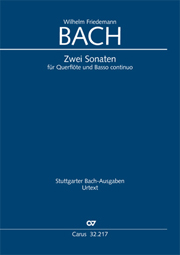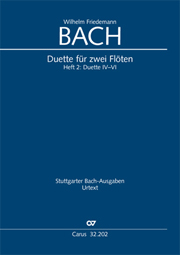Surprises from the Bach House
Read about why our colleague Marion Beyer likes to bit her teeth on the “Two Sonatas for Flute and Basso continuo by Wilhelm Friedemann Bach …
His works are considered to be bizarre, virtuosic, and difficult to grasp: Wilhelm Friedemann Bach is a composer who is all too easily described as one who is “strange” and “idiosyncratic.” Despite the increased interest engendered by the commemoration of the 300th anniversary of his birth in 2010, reception of his music today still remains minimal, although in the past two decades an increasing number of his works have been newly discovered and been made accessible to the music world. In particular, Carus has played a large role in this endeavor, in part in conjunction with the Bach-Archiv in Leipzig, which is publishing the complete works of W. Fr. Bach in connection with their research project, the Bach-Repertorium of the Academy of Sciences of Saxony, located in Leipzig; Carus also has established a CD series featuring the music of this composer.
For me the works for flute by this, the oldest of Bach’s sons, are especially attractive and at least one of these is always resting on my music stand, ready to play or practice. I first came in contact with Wilhelm Friedemann Bach’s Six flute duets (Carus 32.201/00, Carus 32.202/00) when I studied the flute. They are characterized by the contrapuntal structure of the voices and presuppose a high degree of technical performance ability. I simply cannot get enough of playing these interesting duets. Virtuosity and refinement are also characteristic traits of both the E minor and F major flute sonatas (Carus 32.217/00), each of which begins with a fast movement, followed by a slow middle movement, and concluding, once again with a fast movement. One can easily become overtaxed by their many large intervallic leaps and their tricky motivic connections. For flute compositions composed in the first half of the 18th century, technically the Sonatas are extremely demanding but they are truly worth discovering. They are a testimony to Friedemann Bach’s highly individual compositional style and occupy a special place among the works of the Bach Family and within all music from the beginning of the 18th century.
I have often performed the Sonatas in chamber music concerts, preferably together with works by Johann Sebastian or Carl Philipp Emanuel Bach in order to show the diversity of these composers, and in so doing have often sensed the interest, amazement and surprise of the audience. The works of Wilhelm Friedemann Bach defy any comparison to those of his contemporaries. They are full of musical wit and are just waiting to be discovered! Thus our editions, edited by the leading Bach scholar, Peter Wollny, provide an ideal way to discover this outstanding music.
Marion Beyer studied musicology and flute, with an emphasis on early music, and has been employed in the communications department at Carus since September 2015, where she is responsible for online marketing.








Leave a Reply
Want to join the discussion?Feel free to contribute!